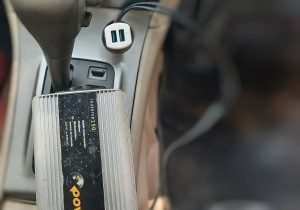Power inverters in the car or RV help keep our favorite gadgets – the laptop, phone chargers and others powered while on the move. When used properly, they can be used for a long time with no harm to our car or RV.
In this post, I will explore 3 ways power inverters can be bad for your car and how to prevent damage to your car.
1. Power inverters can cause damage to cigarette lighter socket circuitry
When you connected an appliance to an inverter plugged into your car’s cigarette lighter socket that draws more than 10-15 A (usually the maximum provided for a cigarette lighter circuit), the corresponding fuse in the cigarette lighter circuit will blow.
Does your consume more that 150W? If so, do not plug the inverter into the car’s cigarette lighter socket. Smaller appliances like laptops, digital cameras, TVs, fan, refrigerators, game console, DVD/Blu-Ray player, GPSes pose no damage to the wiring provided they consume less than 150-180W (check your car’s manual).

150W car power inverter
In general, do not plug appliances such as electric heaters, hair dryers into the inverter plugged into the car’s cigarette lighter socket as they will likely draw more than 150-180W.
Power inverters plugged into poor quality weakly attached or soldered cigarette socket plug connection can damage the car’s wiring when there is a high current draw. In some cases, users reported melted cigarette lighter sockets when there was a high current draw.
To prevent damage to the cigarette lighter socket circuitry, in general your inverter loads should not exceed 150-180W.
If you must power loads larger than 150-180W, consider wiring them directly to the battery. Make sure you use the right size of battery cable to prevent overheating and damage to the car’s wiring.
2. Inverters can drain your car’s battery flat
Are you powering any appliances using an inverter connected to your car’s battery? Make sure your car’s engine is running to prevent draining of your battery’s power.
Most inverters have a low battery voltage cut-off of 10.5V which leaves the battery without enough power left over to start a car!
To avoid draining your car battery flat:
- Always keep your car’s engine running to keep your battery topped up.
- Consider using a good quality low voltage disconnect switch to automatically isolate the battery before its charge drops to such low levels where it will not start the car.
- You can also consult an auto technician to advise how to can connect an extra battery dedicated to powering your inverter.
3. Power inverters can damage your car’s battery
Aging or poor quality batteries have a higher risk of suffering permanent damage when deeply discharged frequently. Therefore, when using an inverter with your car’s battery:
- always keep your engine running
- use a low voltage disconnect switch to isolate the battery before it is deeply discharged.
All in all, whereas power inverters connected to you car’s battery help you enjoy the conveniences and functionality of your appliances when on the move, there is a danger that they may be bad for your car.
Should the power inverter be connected to the cigarette lighter socket:
- the maximum appliance load connected to the inverter should not greater than 150-180W (depending on the car manufacturer).
- keep the car’s engine running when powering appliances for a long time. Use a low voltage disconnect to isolate the battery to prevent deep discharge.
Related Topics
Buying guide for inverters
How to estimate your battery’s runtime with different appliances
